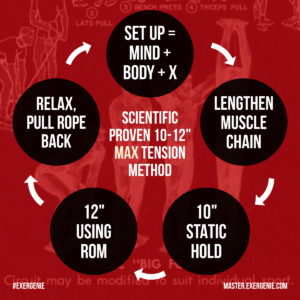In the fast-paced modern world, the pursuit of physical and mental well-being often feels like a balancing act. Ancient practices like Qi Gong, as described by masters such as Shi Heng Yi, and modern fitness innovations like the 10/12 method with the Exer-Genie Short Line System, offer unique yet strikingly similar approaches to achieving this balance. Despite their origins in vastly different times and cultures, these methods converge on principles that emphasize the interplay of relaxation and tension, mindful awareness, and structured progression.
For Western readers seeking to deepen their understanding of these practices, let’s explore the parallels between Qi Gong and the 10/12 method, and how they can harmonize to elevate your physical, mental, and even spiritual fitness.
Qi Gong: The Art of Energy Transformation
Qi Gong, rooted in ancient Chinese traditions, is a practice that integrates movement, breathing, and meditation to cultivate energy (Qi) and promote holistic well-being. According to Shi Heng Yi, Qi Gong emphasizes the following principles:
- Balancing Relaxation and Tension: Maximum relaxation during rest and full engagement during tension exercises. The transition between these states is crucial for energy creation and transformation
- Body Awareness: A deep focus on posture and movement, from the feet to the spine, to enhance internal transformation and physical alignment
- Breathing Synchronization: Coordinating breath with movement to achieve a seamless flow and heightened awareness
- Consistency and Effort: High-intensity practice, preferably in the morning, is essential for meaningful results
The 10/12 Method: Evidence-Based Strength and Flexibility
The 10/12 method, developed for the Exer-Genie Short Line System, combines isometric and isotonic exercises to enhance strength, flexibility, and neuromuscular efficiency. The method is structured into five distinct phases, each contributing to a complete cycle of relaxation, tension, and controlled movement:
- Preparation: Begin the next exercise in a state of total relaxation, preparing both mind and body for the effort ahead
- Lengthening: Enter the exercise by relaxing and lengthening the muscles or muscle chains to their maximum range, ensuring full flexibility and readiness.
- Isometric Contraction: Hold a contraction for 10 seconds at 60-80% effort to activate and stabilize neuromuscular pathways
- Maximal Contraction: Continue with the same effort but engage the muscles or muscle chains as much as possible, creating intense tension and maximizing energy output
- Relaxation and Reset: After the 12-second contraction, relax completely while pulling the rope back or switching to the other hand (if using the Exer-Genie reciprocally). Use this phase to reset your mind and body for the next repetition

The protocol recommends a minimum of two to three repetitions per chosen exercise (preferably adapted to your own understanding and constantly developing until the whole body is worked on), performed at least three times a week, within a pain-free range of motion. This phased approach ensures effective results without overexertion. The eccentric phase (lengthening) improves muscle-tendon flexibility, while the isometric contraction builds strength and reduces strain injury risks.
A Note on Eccentric Training with the Exer-Genie
While eccentric training (resistance during muscle lengthening) is possible with certain exercises using the Exer-Genie, it often requires the practitioner’s body weight to create the necessary load. This makes it effective in some movements, such as pulling or pushing exercises, but less feasible for others, such as squats, where the practitioner’s weight alone cannot provide adequate eccentric resistance. However, the device’s unique design still allows for dynamic and adaptable resistance, offering immense flexibility for most training needs.
The Common Ground: Relaxation, Tension, and Awareness
At first glance, Qi Gong and the 10/12 method may seem worlds apart – one steeped in ancient philosophy and the other rooted in modern sports science. However, their underlying principles reveal a profound synergy:
Relaxation and Tension:
- In Qi Gong, the alternation between deep relaxation and intense tension is the cornerstone of energy transformation. Similarly, the 10/12 method alternates phases of total relaxation, controlled lengthening, isometric contraction, maximal tension, and full relaxation, creating a balanced approach to muscle engagement and recovery
Body Awareness:
- Both practices emphasize the importance of mindful movement and posture. Qi Gong practitioners focus on feeling and correcting their posture from feet to spine, while the 10/12 method encourages precise form and controlled movements using the Exer-Genie
Breathing and Flow:
- Qi Gong’s synchronized breathing – inhale with upward movements, exhale with downward movements – finds a parallel in the deliberate pacing of the 10/12 method. Controlled breathing enhances focus and supports the smooth execution of exercises
Consistency and Progression:
- Qi Gong requires daily practice for meaningful results, much like the structured and progressive approach of the 10/12 method. Both demand regular effort and dedication to unlock their full potential
A Practical Fusion for the Western Practitioner
For those intrigued by the harmony between these practices, integrating Qi Gong principles into your 10/12 method routine can amplify the benefits:
- Start with Breathing: Before beginning your 10/12 exercises, take a few moments to practice Qi Gong breathing. Inhale deeply as you visualize energy flowing through your body, and exhale slowly to release tension
- Focus on Transitions: As you move through the five phases of the 10/12 method, pay attention to the transitions. Engage fully during the tension phases and relax mindfully during the preparation, lengthening, and relaxation phases, just as in Qi Gong
- Mindful Posture: Whether standing or seated, maintain awareness of your posture. Align your spine, ground your feet, and engage your core to enhance both stability and energy flow
- Consistency is Key: Dedicate time each morning to this combined practice. The structured intensity of the 10/12 method complements the energy transformation of Qi Gong, setting a positive tone for the day
Transforming Fitness and Energy
The fusion of Qi Gong and the 10/12 method offers a unique pathway to balance, strength, and transformation. By embracing the ancient wisdom of Qi Gong and the modern innovation of the Exer-Genie, Western practitioners can experience a holistic approach to fitness that nurtures both body and mind.
